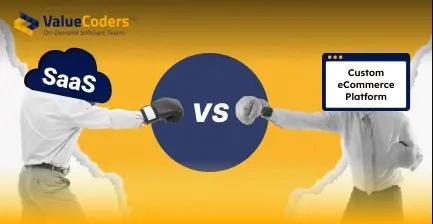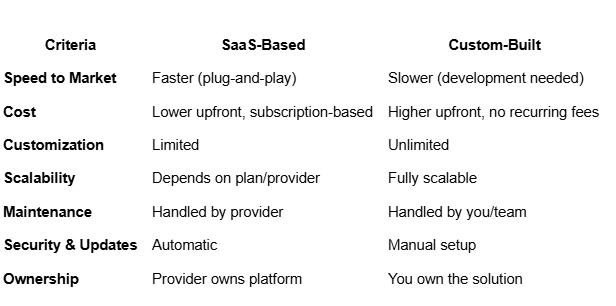
The eCommerce market continues to expand at a remarkable pace, with more businesses than ever shifting their focus to online sales channels. As digital storefronts become central to business success, picking the right eCommerce platform has never been more crucial.
Your platform choice impacts everything from day-to-day operations to long-term growth potential. Make the wrong decision, and you might face limitations that hinder your business progress. Choose wisely, and you create a foundation for sustainable growth.
Today, businesses typically choose between two main options: SaaS-based eCommerce platforms and custom-built solutions. Each approach offers distinct benefits and limitations that must align with your specific business needs.
What Is a SaaS-Based eCommerce Platform?

A SaaS-based eCommerce platform is a pre-built online storesolution that lets you host your store with a third party, such as Shopify, BigCommerce, Wix eCommerce, or Squarespace. Furthermore, with SaaS consulting and development services you get everything needed to smoothly run youronline store.
Key Features
Hosted Infrastructure: The provider manages servers, security patches, and system maintenance
Pre-built Templates: Ready-made design themes that need minimal customization
Built-in Payment Processing: Standard payment gateways ready for activation
Automatic Updates: Regular system improvements without manual intervention
Standard Integrations: Common third-party apps and services available through marketplaces
Technical Support: Help desks and knowledge bases are included in subscription fees
Ideal Users
SaaS based eCommerce platforms work best for:
First-time store owners looking to test market viability
Small businesses with limited technical skills
Companies working with tight launch timeframes
Startups operating with modest initial budgets
Businesses with straightforward product catalogs
Retailers with standard sales processes
What Is a Custom-Built eCommerce Platform?

A custom-built eCommerce platform represents a tailor-made online store created specifically for your business requirements. This approach involves building from scratch or heavily modifying open-source frameworks like Magento, WooCommerce, or PrestaShop.
Key Features
Complete Design Freedom: No limitations on user interface or customer experience
Unique Functionality: Built specifically around your business processes
Full Code Ownership: Direct access to modify any aspect of the platform
Custom Database Structure: Data organization optimized for your specific needs
Bespoke Integrations: Seamless connections with your existing business systems
Unique User Flows: Shopping experiences designed around your specific customers
Ideal Users
Custom eCommerce platforms work best for:
Established businesses with unique operational needs
Companies with complex product configurations
Enterprises needing deep integration with existing systems
Businesses in specialized industries with unique compliance requirements
Retailers expecting high traffic volumes and transaction rates
Organizations with access to technical development resources
READ MORE: A Comprehensive Guide On SAAS Application Development Challenges & Solutions
A Comparative Analysis: SaaS vs Custom eCommerce Platform

There are some important parameters, like cost, scalability, etc., that are used in the eCommerce platform comparison.
Let’s look at the detailed analysis of “SaaS vs Custom eCommerce platform

1. Cost and Budget
SaaS based eCommerce Platforms
SaaS eCommerce solutions follow a subscription-based pricing model that spreads costs over time:
Initial setup fees: $0-5,000 depending on complexity
Monthly subscription: $30-300+ based on features
Transaction fees: Often 0.5-2% per sale on basic plans
App costs: $10-200+ monthly for additional functionality
Theme costs: $0-350 for premium designs
These platforms are easily accessible to small businesses due to their cost-effectiveness initially. However, as your store grows, recurring fees can accumulate substantially.
Custom Platforms
Custom development involves significant upfront investment:
Initial development: $20,000-250,000+ based on complexity
Hosting expenses: $200-2,000+ monthly for reliable service
Ongoing maintenance: $1,000-10,000+ monthly for development staff
Security updates: Regular investment in patches and testing
No platform transaction fees: Keep 100% of sales revenue
While the upfront costs seem steep, businesses handling high transaction volumes often see better long-term value by avoiding per-sale fees.
2. Time to Market
SaaS Platforms
Speed represents one of the biggest advantages of SaaS solutions:
Store setup: 1-7 days for basic configuration
Template customization: 1-4 weeks for brand alignment
Product uploading: Immediate with bulk import tools
Payment configuration: Minutes with pre-built integrations
Testing cycles: Shortened due to pre-tested components
Many small businesses can have a functional store running within days, perfect for quick market entry or testing new concepts.
Custom Platforms
Custom development follows a more traditional software timeline:
Planning phase: 2-8 weeks for requirement gathering
Development stage: 3-9 months for coding and building
Testing periods: 1-3 months for quality assurance
Deployment preparation: 2-4 weeks for server setup
Launch window: Several days for final cutover
The extended timeline means businesses must plan well in advance of desired launch dates, often starting development 6-12 months before going live.
3. Scalability & Flexibility
SaaS Platforms
SaaS solutions offer predictable but constrained scalability:
Traffic handling: Pre-set limits based on plan tier
Feature access: Restricted by subscription level
Customization depth: Limited to available extension points
Multi-channel selling: Often requires premium plans
International expansion: Varies by platform capabilities
While upgrading plans can address some scaling needs, fundamental platform limitations eventually create growth ceilings that businesses can't overcome.
Custom Platforms
Custom solutions shine when it comes to growth potential:
Traffic capacity: Limited only by your hosting investment
Feature expansion: Unlimited ability to add functionality
Architectural changes: Freedom to restructure as needed
Integration possibilities: Connect with any external system
Geographic adaptation: Full control over regional customizations
This unrestricted scalability means the platform can evolve alongside your business without hitting arbitrary limitations.
4. Product Management
SaaS based eCommerce Platforms
Product management follows standardized approaches:
Product limits: Often capped at 5,000-100,000 items depending on plan
Variant restrictions: Typically limited to 3-4 product options
Bulk operations: Basic import/export capabilities
Category structure: Preset organizational patterns
Digital products: Limited handling capabilities on basic plans
These constraints rarely affect small businesses but become problematic as catalog complexity increases.
Custom Platforms
Custom development removes product management restrictions:
Unlimited products: No artificial caps on catalog size
Complex configurations: Support for sophisticated product options
Advanced inventory: Custom stock management rules
Specialized categorization: Industry-specific organizational models
Mixed product types: Seamless handling of physical, digital, and service offerings
Businesses with large or complex catalogs gain significant operational efficiency from these customizations.
5. Performance & Load Handling

SaaS Platforms
Performance depends on shared infrastructure:
Page load times: Generally 2-5 seconds on standard plans
Traffic spikes: Limited ability to handle sudden increases
Concurrent users: Performance degradation with high visitor counts
Database operations: Throttling during peak processing times
Resource allocation: Shared with other stores on the platform
Performance issues often emerge during high-traffic events like sales promotions or holiday shopping periods.
Custom Platforms
Custom solutions allow for performance optimization:
Server configuration: Tailored to your specific traffic patterns
Code efficiency: Optimized for your particular products and features
Caching strategies: Custom-built for your content needs
Database tuning: Structured around your specific data access patterns
Resource scaling: On-demand increases during peak periods
This performance advantage becomes crucial for businesses where page speed directly impacts conversion rates.
6. Integration & Custom Features
SaaS Platforms
Integration capabilities depend on available apps and APIs:
App marketplace: Pre-built connections to eCommerce development services
API limitations: Restricted access to certain platform functions
Customization depth: Limited to what the platform allows for users
Update compatibility: Apps may break with platform updates
Development restrictions: Limited ability to modify core functions
While app ecosystems continue to grow, businesses with specialized needs often find themselves creating workarounds for missing functionality.
Custom Platforms
Integration flexibility stands as a major advantage:
Unlimited connections: Interface with any external system
Complete API freedom: Build exactly what your business requires
Workflow automation: Custom processes between systems
Legacy system integration: Connect with older business software
Proprietary systems: Build unique features for competitive advantage
This integration flexibility helps businesses create seamless operations across their entire technology ecosystem.
7. Maintenance & Support
SaaS Platforms
Platform maintenance is handled by the provider:
Security updates: Automatic implementation
Feature additions: Rolled out platform-wide
Bug fixes: Handled by provider's team
Compliance updates: Managed centrally
Server monitoring: 24/7 by provider staff
This hands-off approach saves significant technical overhead for businesses without IT departments.
Custom Platforms
Maintenance responsibility falls to your business:
Security vigilance: Constant monitoring required
Update planning: Careful testing of changes needed
Bug resolution: Internal or contracted developers needed
Compliance tracking: Your team must stay informed of requirements
Infrastructure management: Server expertise required
This control comes with responsibility, requiring dedicated technical resources either in-house or through trusted partners.
Some Important Business Use Cases
Before making your final choice, it is important to consider the best use cases for both platforms. Here, you will find when to use which platforms, as discussed below:
When to Choose SaaS eCommerce Platform?

SaaS-based eCommerce platforms make the most sense in several common scenarios:
New Market Testing
Quickly launch minimum viable products
Test product-market fit with minimal investment
Gather customer feedback before larger investments
Validate business models with real transaction data
Pivot quickly based on market response
Resource-Limited Operations
Small businesses without technical staff
Startups conserving capital for other areas
Solo entrepreneurs handling all business aspects
Companies focusing resources on product development
Seasonal businesses with fluctuating needs
Standard Retail Models
Straightforward product catalogs
Traditional checkout processes
Common payment methods
Standard shipping requirements
Typical customer account features
Fast Launch Requirements
Seasonal or trend-based products
Event-related merchandise
Crisis response offerings
Competitor response strategies
Marketing campaign support
READ MORE: SaaS vs. Custom eCommerce Platforms: What’s Best for Startups?
When to Choose a Custom-Built eCommerce Platform?
Custom-built eCommerce platforms deliver the most value in these situations:
Complex Business Rules
Sophisticated pricing models
Intricate discount structures
Custom approval workflows
Complex shipping logic
Specialized inventory rules
High-Volume Operations
Stores processing thousands of daily orders
Sites handling millions of monthly visitors
Platforms supporting thousands of concurrent users
Catalogs with tens of thousands of products
Businesses with peak season traffic spikes
Unique User Experiences
Specialized product configurations
Custom checkout processes
Personalized shopping journeys
Industry-specific buying patterns
Unique customer relationship models
System Integration Requirements
ERP connections
CRM synchronization
PIM system integration
Custom fulfillment processes
Proprietary back-office systems
Specialized Industry Needs
B2B commerce with account management
Subscription-based selling
Configure-price-quote functionality
Industry-specific compliance requirements
Special taxation or regulatory needs
Conclusion
The “SaaS vs custom eCommerce platform” choice comes down to your specific business needs, resources, and goals.
SaaS platforms offer accessibility, speed, and simplicity. They make perfect sense for businesses seeking quick market entry, predictable costs, and minimal technical responsibility.
On the other hand, custom-built solutions provide unlimited flexibility, performance optimization, and long-term cost benefits for high-volume sellers.
Whatever your choice, remember that your eCommerce platform represents one of your most important business tools; not just a website, but the digital foundation of your customer relationships and revenue generation. So, choose wisely!


Write a comment ...